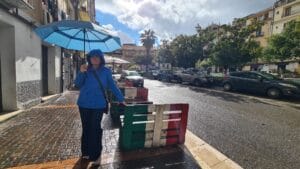
Lamezia Terme: The Blog That Nearly Didn’t Happen – By Andy
A2Z Wander | Our Blog A Rainy Arrival (and a Slight Hangover) Lamezia Terme almost didn’t get its own blog post. There’s only so many
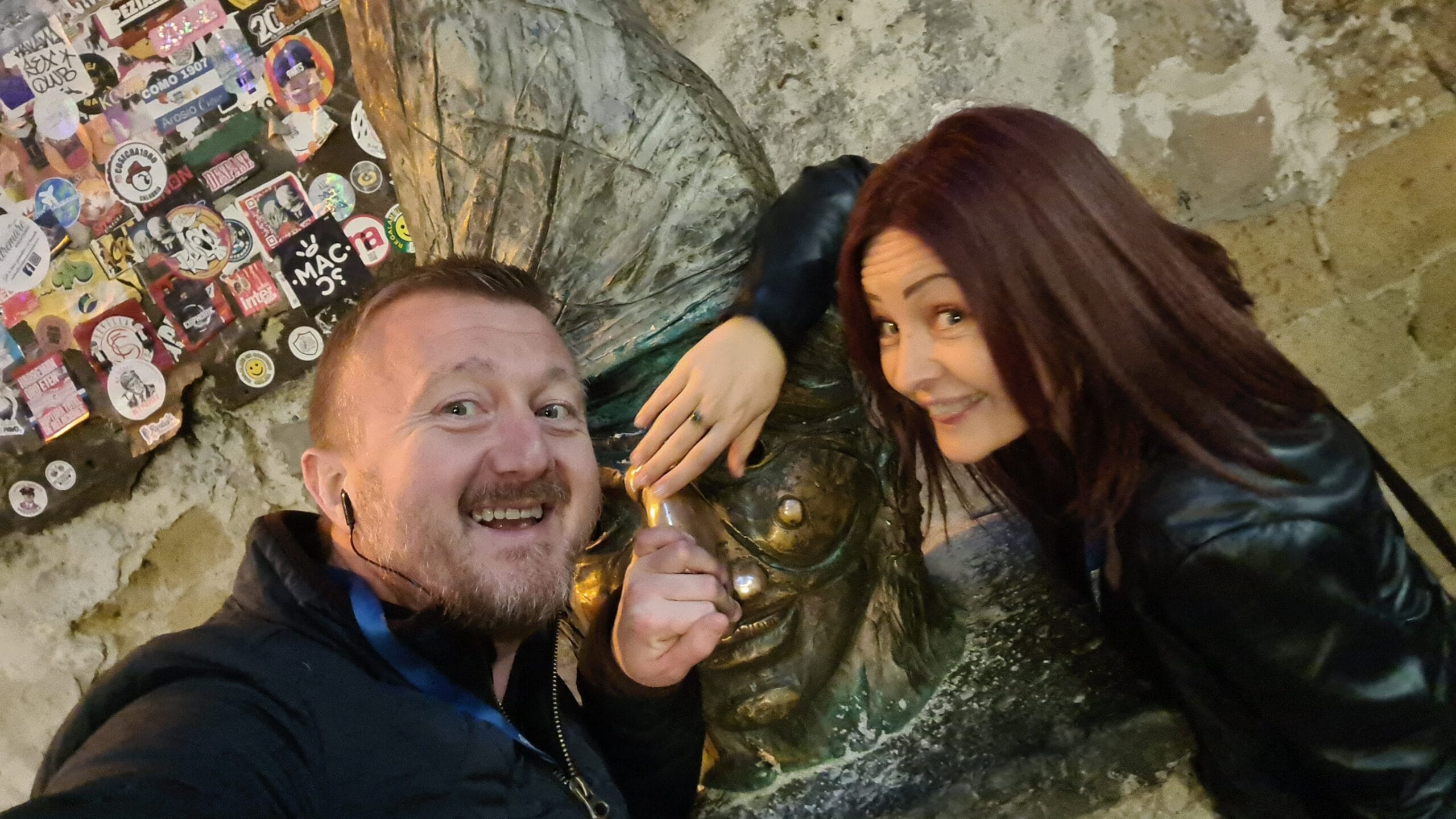
They say you either fall head over heels for Naples or run screaming to the nearest high-speed train. I, for one, am firmly in the former camp—three visits in and I’m still not over the noise, the chaos, the scooters that defy logic, or the espresso that hits your nose the moment you enter the city. And of course, the food. Oh, the food.
(a little video of the scooters passing us by)
Naples isn’t just a city—it’s a sensory ambush. A living, breathing contradiction. Perched between the shimmering Bay of Naples and the brooding presence of Mount Vesuvius, it hums with an energy that’s equal parts ancient and anarchic. We even had a small earthquake while we were there (more on that to follow), just a reminder from the volcano that it’s still in charge, though not the one you’re probably thinking of! But rather than live in fear, Neapolitans seem to have absorbed that unpredictability into their spirit—resilient, passionate, and unapologetically alive.
There’s so much to say, yet it’s the hardest blog so far to write. Naples is complicated.
Yes, it’s messy—there’s rubbish on the streets, pavements that are cracked, potholed, or sometimes don’t exist at all, and you constantly have to watch where you’re stepping. Crossing the road is a battle of wills, as traffic signals here are more of a suggestion than a rule.
It’s huge and busy. The capital of the Campania region and the third most populated city in Italy, after Rome and Milan, with just under one million people living in the centre and 4.5 million in the greater metropolitan area.
Sure, the city still suffers from its fair share of bad press. Some of it earned, much of it outdated, and a lot of it the peddling of lazy clichés. There’s no denying it’s chaotic, overwhelming, and sometimes claustrophobic. Like any metropolis, the area around the main station feels a bit dodgy, just like Camden Town tube on any given day.
But it’s also creative, soulful, and fiercely proud. And if you really want to begin to understand Naples—not just tick off the sights or queue for a famous slice of pizza—then you need to spend time in its small streets, learn its history, and look beneath the surface.
Here, history isn’t something trapped behind glass in a museum—it’s alive in the streets, in the stories people tell, and most of all, in the food.
It’s the perfect place to join a local guide and follow them through the backstreets. This is a city that rewards curiosity, but it helps to have someone whispering its secrets along the way.
And those secrets often come served on a plate or in a glass, with stories folded in alongside the flavours.
And so, armed with empty stomachs and a generous dose of inquisitiveness, we set off on a street food tour that promised to feed not just our senses, but also our hearts and minds.
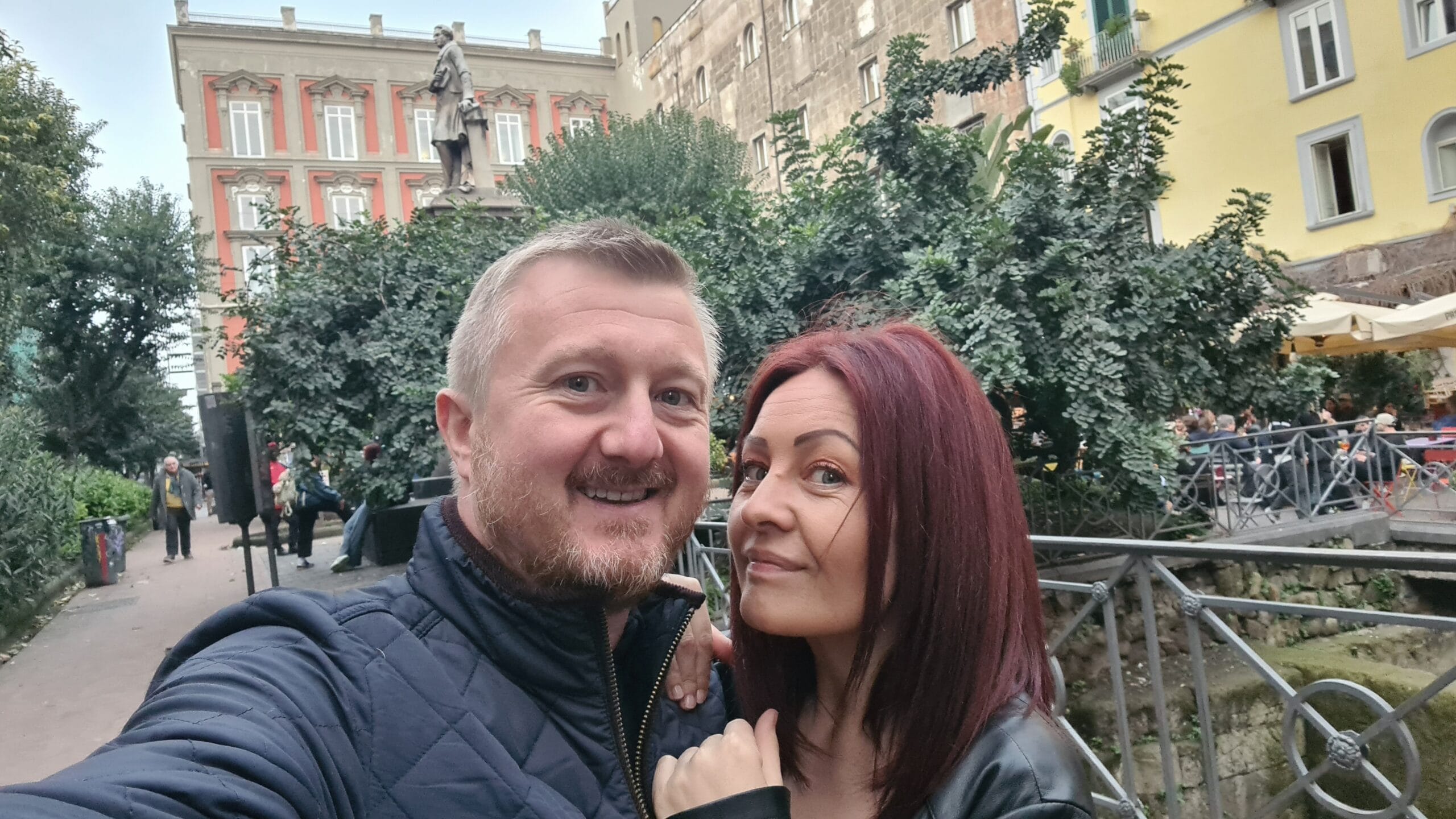
Andy successfully navigated us to our meeting point, Piazza Bellini, which is no small feat in these streets, and a responsibility I was glad not to have. (Pre-trip planning, accommodation and activities fall under my remit; navigation and transport schedules are firmly in his.) Not least because in Naples, simply watching where you’re going demands most of your concentration. A point our guide Mario confirmed as he welcomed us and the rest of our group.
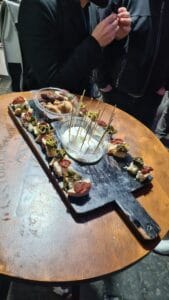 First stop: Zinzi, for some antipasti.
First stop: Zinzi, for some antipasti.
Olives. Taralli—those small, ring-shaped savoury biscuits found across Italy, with the Neapolitan version studded with almonds and black pepper. Bread topped with sun-dried tomatoes and friarielli—a tangle of bitter greens unique to Naples. And then, of course, the main event: buffalo mozzarella.
Naples and stories are inseparable. Over the next four days, we’d hear more legends than in all our time elsewhere in Italy. That in itself says something about the people—their history, their humour, and their passion for myth-making.
Not just any mozzarella. Mozzarella di bufala—made from rich, tangy buffalo milk and regarded as the finest. It’s twice the price of the regular stuff, with a more complex flavour and perfect meltability. Ideal for pizza. Sacred, even.
Like so much in Naples, even cheese comes wrapped in mythology—a blend of craftsmanship, tradition, and a little bit of theatre.
Mario, with the flair of a game show host, asked if anyone knew the rules. Blank faces all round.
Rule one: Never, ever put it in the fridge. The texture and flavour profile will change. Instead, store it in a cool place in its whey liquid.
Rule two: Eat it within two days.
What happens if you don’t?
With a mischievous glint in his eye, Mario explains: “If it’s not eaten in two days… we export it!”
We laughed—and instantly understood where the bland, slimy stuff we get in the UK comes from. Fair enough, really. Why shouldn’t they keep the good stuff for themselves? In Naples, there are two religions: food and football. And with every bite, we were being baptised into the first.
 Speaking of mischief, en route to our next stop, we passed the unofficial mascot of Naples: the Pulcinella statue, where we paused to rub his nose for luck and fortune.
Speaking of mischief, en route to our next stop, we passed the unofficial mascot of Naples: the Pulcinella statue, where we paused to rub his nose for luck and fortune.
Every corner here tells a story, and every figure—whether carved in stone or kneading dough—carries the spirit of Naples in its bones.
Pulcinella, the iconic Neapolitan carnival mask, embodies the spirit of the city—witty, resilient, and deeply rooted in tradition—confronting life’s ups and downs with humour, music, and a love of good food. Classic images show him joyfully devouring spaghetti with tomato sauce or a proper pizza margherita, and it’s fitting—because in Naples, food and folklore are never far apart. Our next stop? The pizza margherita.
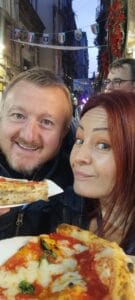 Naples is the birthplace of pizza, and pizza margherita is its most iconic creation. Its beauty lies in its simplicity: just three ingredients, representing the colours of the Italian flag—fresh mozzarella for white, basil for green, and vibrant red tomato sauce. Ah, but not just any tomatoes. The best come from San Marzano, grown in the volcanic soil at the base of Mount Vesuvius. The unique mineral-rich earth and Mediterranean climate give these tomatoes their distinctive sweetness and low acidity, making them the perfect base for pizza.
Naples is the birthplace of pizza, and pizza margherita is its most iconic creation. Its beauty lies in its simplicity: just three ingredients, representing the colours of the Italian flag—fresh mozzarella for white, basil for green, and vibrant red tomato sauce. Ah, but not just any tomatoes. The best come from San Marzano, grown in the volcanic soil at the base of Mount Vesuvius. The unique mineral-rich earth and Mediterranean climate give these tomatoes their distinctive sweetness and low acidity, making them the perfect base for pizza.
The margherita itself was named in honour of Queen Margherita of Savoy, who visited Naples in 1889. Legend has it that a local pizzaiolo (pizza chef), Raffaele Esposito, created a patriotic pizza in her honour—simple, elegant, and utterly Neapolitan. Over a century later, it’s still hard to beat.
While Neapolitan pizza itself isn’t on the UNESCO list, the Art of the Neapolitan Pizzaiuolo is recognised as an Intangible Cultural Heritage for the skill, tradition, and expression involved in its creation. It’s not just about technique, but also the gestures, attitude, and even the unique language used by the pizzaioli that make it a true cultural art form.
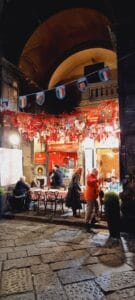 We ate ours standing on the pavement, outside a tiny pizzeria that looked like it hadn’t changed in decades. Posters and bunting of Diego Maradona—Naples’ adopted saint—adorned every surface. Strings of twinkling lights hung overhead, along with bright red cornicelli—the horn-shaped charms said to bring good luck and protect against malocchio – the evil eye. These small talismans are everywhere in Naples, from rear-view mirrors to market stalls. There’s a whole story behind them, too: you’re not supposed to buy one for yourself (it should be gifted), and if you do, you should never pay full price—otherwise, you risk attracting bad luck!
We ate ours standing on the pavement, outside a tiny pizzeria that looked like it hadn’t changed in decades. Posters and bunting of Diego Maradona—Naples’ adopted saint—adorned every surface. Strings of twinkling lights hung overhead, along with bright red cornicelli—the horn-shaped charms said to bring good luck and protect against malocchio – the evil eye. These small talismans are everywhere in Naples, from rear-view mirrors to market stalls. There’s a whole story behind them, too: you’re not supposed to buy one for yourself (it should be gifted), and if you do, you should never pay full price—otherwise, you risk attracting bad luck!
With hot pizza in hand, Maradona on the wall, and Pulcinella looking on, it was one of those perfect, only-in-Naples moments. Loud, chaotic, a little rough around the edges—but absolutely full of heart. Naples was starting to get under our skin, one bite at a time.
 Next stop? Naturally, another pizza.
Next stop? Naturally, another pizza.
This time, pizza fritta—a deep-fried cousin of the classic version, served piping hot and filled with cheese and tomato. Gooey, indulgent, and pure comfort food.
Mario asked which we preferred. The group was split. Personally, I’m in the classic camp—the clean flavours and textures win me over.
Andy happily finished my pizza fritta (after I’d burnt my tongue and wondered how I was going to make it to the end of the night, considering this was only stop three!).
Mario’s announcement that we needed a break from all the heavy food was like music to my ears – the next stop, a limoncello factory, Limone fabrica di Limoncello.
Tucked away near the ancient heart of Naples, not far from the Decumano Maggiore, we found Limoné—a small, family-run liqueur shop dedicated to preserving traditional Neapolitan flavours. From the moment we stepped inside and saw the production room tucked behind a shop full of beautifully presented bottles and sweets, I knew we’d found a gem.
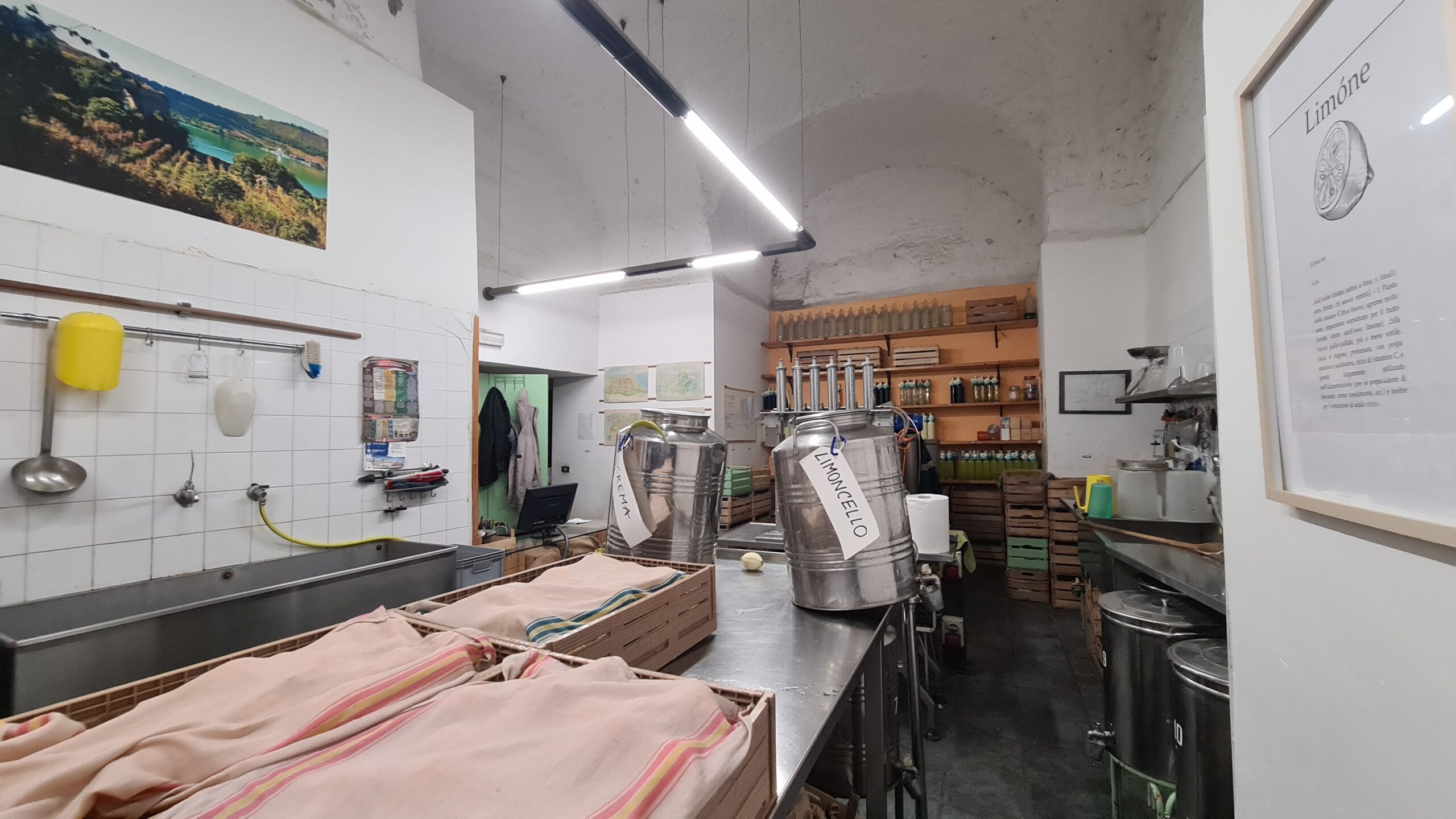
The air was filled with the sweet scent of citrus, and nothing here goes to waste. We were greeted with genuine warmth, and the banter between our guide Mario and the owner set the tone for what felt more like a visit to an old friend than a shop. The staff’s passion was infectious as they explained the process behind their handmade limoncello. It’s no wonder Limoné comes recommended by the likes of Lonely Planet and Le Routard—it’s more than just a shop, it’s a taste of Naples, bottled.
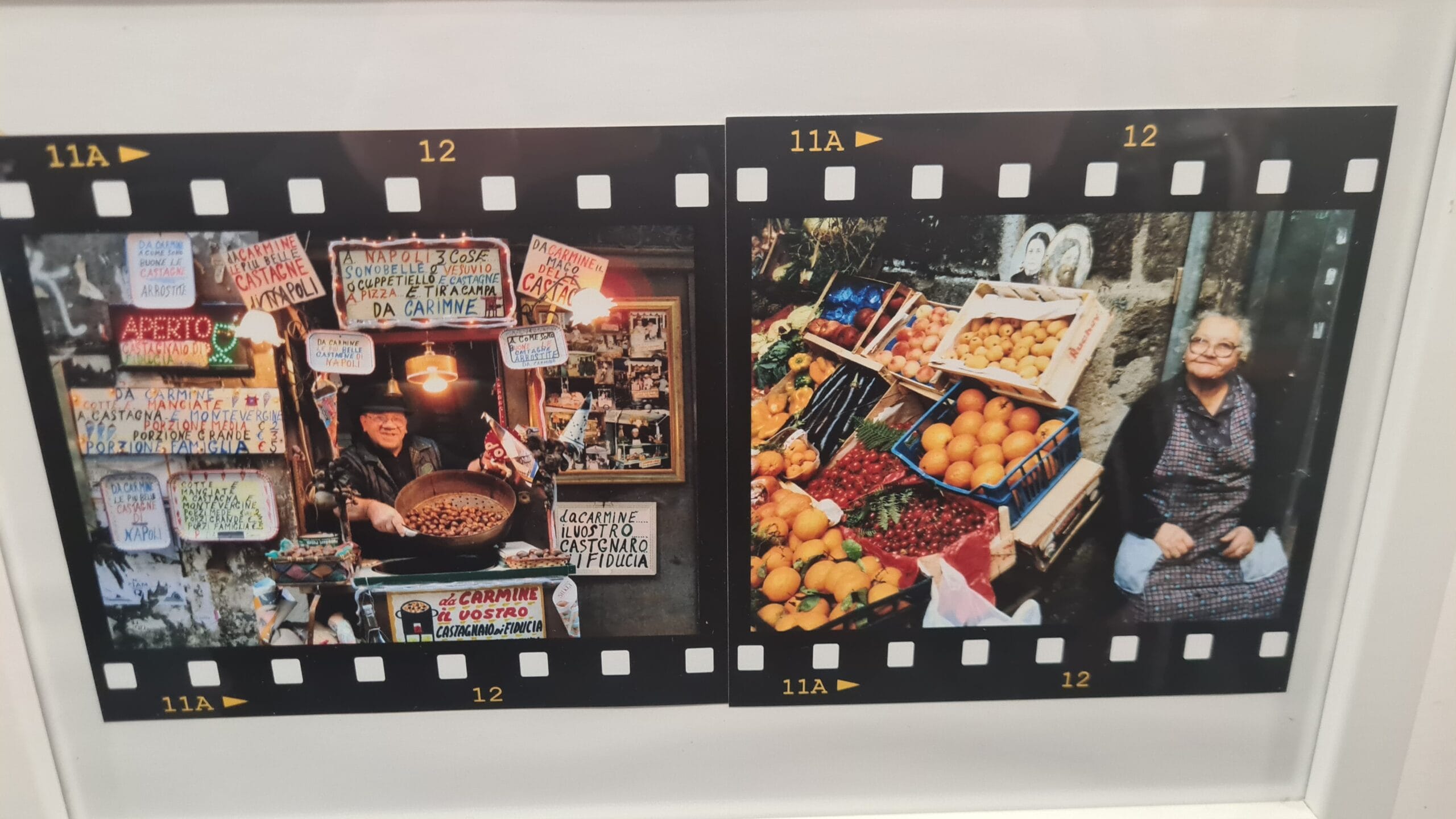
 Their signature limoncello is made using verdello lemons—a vibrant green variety grown without chemicals in the volcanic soil of the Campi Flegrei (the volcano that caused our earthquake).
Their signature limoncello is made using verdello lemons—a vibrant green variety grown without chemicals in the volcanic soil of the Campi Flegrei (the volcano that caused our earthquake).
Each lemon is peeled by hand, staying true to a family recipe passed down through generations.
But Limoné doesn’t stop at liqueurs—they’ve turned their love of lemons into an entire range of products: lemon pasta, lemon olive oil, lemon grappa, and lemon chocolate.
We were so inspired, we went back later in the trip to buy some lemon pasta and said chocolate, which disappeared in less than a day. We think it was Little Boof.
 Limoncello is a digestif—it’s meant to be sipped slowly after a big meal to aid digestion. Frankly, we needed all the help we could get because stop five was fried, and then some. I read one review where someone said they’d have preferred less fried food—honestly, same—but that’s par for the course on a street food tour in Naples. So, after a quick waistband adjustment, we pressed on… this time for frittatine di pasta.
Limoncello is a digestif—it’s meant to be sipped slowly after a big meal to aid digestion. Frankly, we needed all the help we could get because stop five was fried, and then some. I read one review where someone said they’d have preferred less fried food—honestly, same—but that’s par for the course on a street food tour in Naples. So, after a quick waistband adjustment, we pressed on… this time for frittatine di pasta.
Crunchy on the outside, soft and creamy in the middle, these fried parcels of pasta were originally created to use up leftovers. Over time, they became more elaborate. To a base of leftover pasta, eggs, and cheese, you’ll now often find minced pork or beef, peas, carrots, béchamel, and ragù added. Once a humble home-cooked snack, frittatine are now a street food icon—and in my humble opinion, far better than pizza fritta!
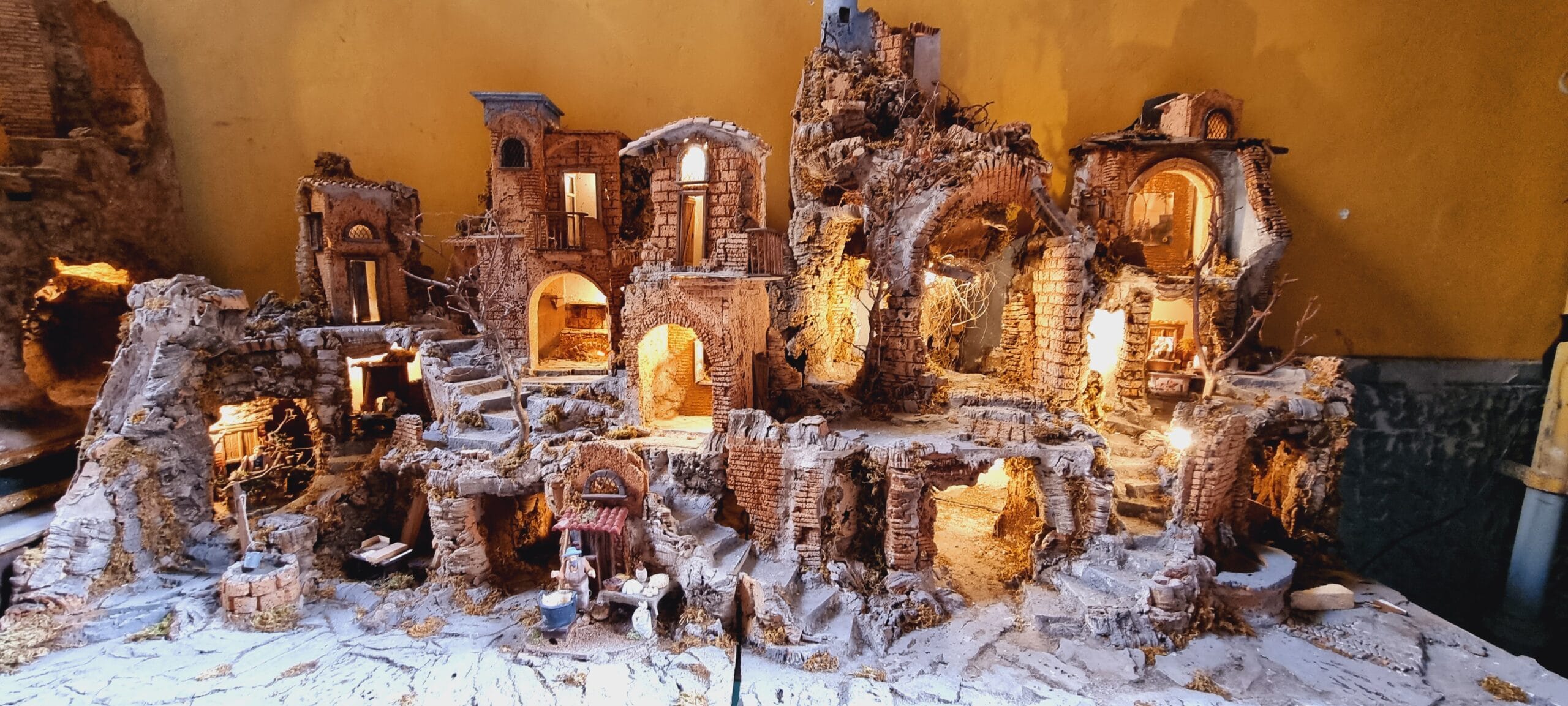
One of the most incredible things about this tour—and something I hope I’m capturing here—is that every single stop was right in the heart of historic Naples. It just felt right. In a city so completely entwined with its food, every step revealed a new wonder, another story, more history.
A stroll down Naples’ famous Via San Gregorio Armeno—nicknamed Christmas Alley—is like stepping into a year-round festive wonderland. Lined with workshops that have handcrafted nativity scenes (presepi) since the 18th century, this historic street offers everything from traditional Holy Family figurines to miniature pizza ovens, footballers, politicians, and even fountains with running water.
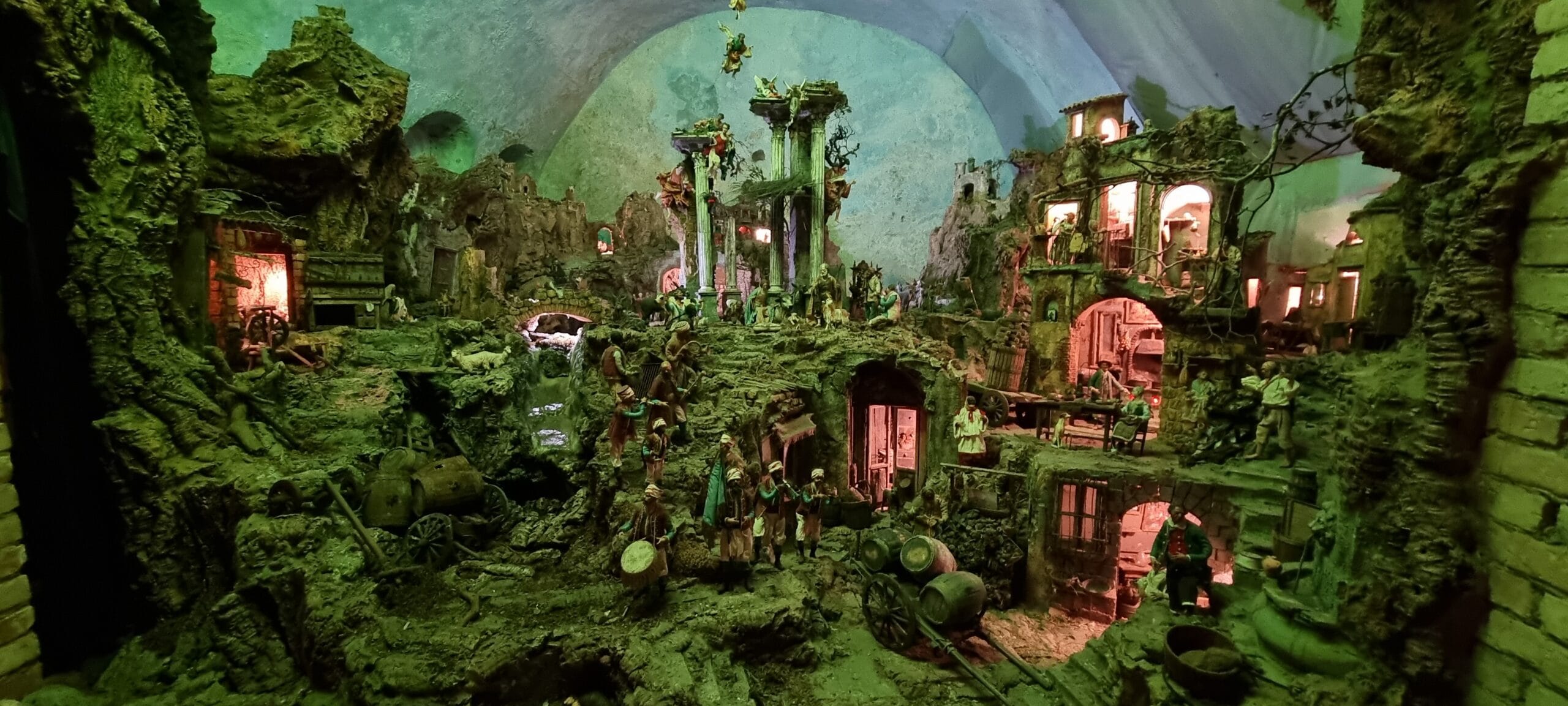
 Even the nativity scenes feel like an extension of the city’s kitchen—bustling with bakers, butchers, and yes, pizza makers—because in Naples, food is life and life is theatre. The presepi are not just religious displays—they’re miniature villages alive with personality, built piece by piece and passed down through generations.
Even the nativity scenes feel like an extension of the city’s kitchen—bustling with bakers, butchers, and yes, pizza makers—because in Naples, food is life and life is theatre. The presepi are not just religious displays—they’re miniature villages alive with personality, built piece by piece and passed down through generations.
I was lucky enough to spend Christmas here a few years ago, and I’ll never forget the magic of spotting a nativity scene tucked into the cliffs along the Amalfi Coast—tiny amber lights glowing, intricate moving parts begging you to pause and admire the craft. On that winding coastal road, a sudden row of brake lights often hints that a scene is just around the next corner.
It’s a magical (and slightly surreal) celebration of craftsmanship and Christmas spirit, deeply rooted in Neapolitan tradition—and like everything in Naples, it’s built on stories.
As we wandered between food stops, Mario kept us entertained with snippets from his childhood growing up in Naples, his stories as much a part of the tour as the food itself. At one point, we passed a souvenir stand displaying wooden spaghetti measures, each hole sized for different servings and decorated with olives, tomatoes, or the Italian flag. With a grin, Mario revealed that in Naples, these weren’t just for measuring pasta, they also doubled as handy tools for keeping unruly children in line. I couldn’t help but picture an Italian nonna wielding one, doling out discipline along with perfectly portioned spaghetti!
In Naples, knowing a few key hand gestures can be just as useful as speaking Italian—maybe even more so!. As a language teacher, I’m fascinated by the idea that gestures have dialects, just like spoken language. The same gesture can mean wildly different things depending on where you are—in Naples, Calabria, or Sicily, a slight variation of the hands can completely change the message.
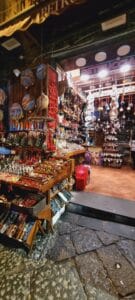 Mario explains the famous two-finger gesture to us. Pointing your index and pinky fingers like horns—called “le corna”—can either ward off bad luck (malocchio, or evil eye) or, if directed at someone, accuse them of being a cuckold (suggesting their partner is unfaithful)—a serious insult in Naples and across southern Italy. The difference? It’s all in the direction of the fingers:
Mario explains the famous two-finger gesture to us. Pointing your index and pinky fingers like horns—called “le corna”—can either ward off bad luck (malocchio, or evil eye) or, if directed at someone, accuse them of being a cuckold (suggesting their partner is unfaithful)—a serious insult in Naples and across southern Italy. The difference? It’s all in the direction of the fingers:
In a city as passionate and expressive as Naples, the hands do almost as much talking as the mouths—and you’ll see gestures like these woven into conversation all over Italy, turning simple exchanges into a kind of physical performance.
We approached our final stop of the evening with mixed feelings—bellies so full we could barely move, but hearts fuller still, of stories we didn’t want to end. But Naples had saved one last treat for us: Pasticceria Carraturo, a bakery that’s been perfecting la dolce vita since 1837.
It all began with Pietro Carraturo, a young farmer from Casamarciano, who, while herding turkeys, lent a hand to a carter whose wagon had slid into a ditch. Grateful, the carter offered him a lift to Naples—and a job in a pastry shop. From those humble beginnings, Pietro opened his own bakery in the city, crafting the iconic sfogliatelle ricce e frolle—the flaky and shortcrust pastries that Naples is famous for. The shop later moved beneath the arch of Porta Capuana before finding its current home on Via Casanova in 1904, where the Carraturo family continues to bake tradition into every bite.
It felt like the perfect place to end—a family-run bakery whose history is as layered as the sfogliatella itself.
 Sfogliatella is my absolute favourite pastry. I don’t have a particularly sweet tooth, but I adore anything with a crunchy texture. For me, this is serious pastry heaven.
Sfogliatella is my absolute favourite pastry. I don’t have a particularly sweet tooth, but I adore anything with a crunchy texture. For me, this is serious pastry heaven.
Its ancestor, the Sfogliatella Santa Rosa, was created in the 17th century by nuns at the monastery of Santa Rosa in Conca dei Marini, just along the Amalfi Coast. Later, in 1818, Neapolitan pastry chef Pasquale Pintauro acquired the recipe and brought it to Naples, where it became a local staple. Today, Pasticceria Carraturo continues this sweet tradition, offering both the riccia (the classic flaky, layered version) and the frolla (a simpler shortcrust take).
Of course, no Neapolitan pastry experience is complete without tasting a babà—a golden, yeasted sponge cake drenched in rum syrup. Light and airy yet rich with butter, the babà strikes that perfect balance between indulgent and delicate. Originally a French creation, it sailed into Naples in the 19th century and quickly became a local favourite. While the classic version is soaked in rum, variations abound—sometimes filled with whipped cream, fruit jams, or studded with candied citrus or currants. However you serve it, babà is as much a part of Naples as pizza and Vesuvius.
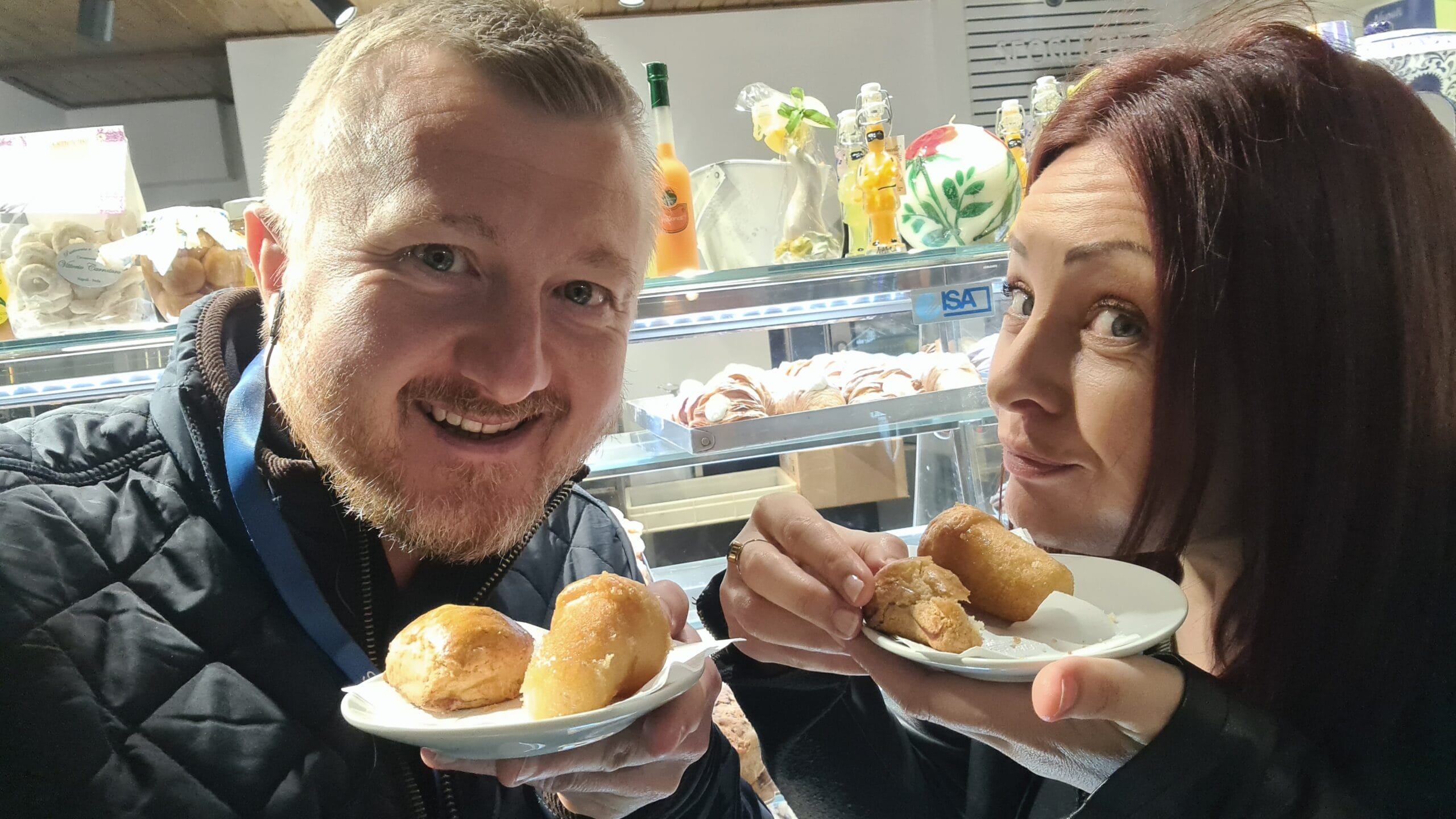
Standing in this historic bakery, surrounded by the scent of sugar and pastry, felt like the perfect ending—one more taste of Naples’ rich history, layered like the sfogliatella itself.
Just enough room for one more story…
If Naples runs on food, it’s fuelled by coffee—not just as a drink, but as a symbol of hospitality, history, and heart. Whether served in the grand cafés once frequented by the likes of Oscar Wilde, Ernest Hemingway, and Jean-Paul Sartre, or in the humbler bars scattered through the backstreets, coffee here is an act of care.
 Nowhere is this more beautifully captured than in the tradition of caffè sospeso—the suspended coffee. The idea is simple: when ordering your espresso, you pay for two—one for yourself, and one for someone who can’t afford it. A quiet gesture that speaks volumes about community spirit.
Nowhere is this more beautifully captured than in the tradition of caffè sospeso—the suspended coffee. The idea is simple: when ordering your espresso, you pay for two—one for yourself, and one for someone who can’t afford it. A quiet gesture that speaks volumes about community spirit.
One of the most iconic spots to enjoy a coffee is Caffè Gambrinus, founded in 1860 and still standing proudly at the edge of Piazza del Plebiscito. Known as the Café of the Seven Doors, it has welcomed writers, artists, and philosophers for over a century beneath its chandeliers and frescoed ceilings—proof that in Naples, coffee is as much about connection as caffeine.
While I enjoyed a late-night coffee, unable to face another bite, Andy and Little Boof opted for the gelato option, combining classic Italian flavours, pistachio and stracciatella.
These small acts, like sospeso, remind me that Naples isn’t just a city you visit. It’s a city that welcomes you, feeds you, and sends you away with stories stitched into your heart.
Follow us on instagram @a2z.wander

A2Z Wander | Our Blog A Rainy Arrival (and a Slight Hangover) Lamezia Terme almost didn’t get its own blog post. There’s only so many

A2Z Wander | Our Blog A short coastal train ride punctuated by dramatic thunderclaps brought us further down into Calabria to a town called Scilla.

A2Z Wander | Our Blog This is quite the introduction to the town of Tropea… This is the view from Belvedere Piazza del Cannone in

A2Z Wander | Our Blog Three weeks into the trip, and we were finally swapping wheels for waves, boarding our first boat along the coast

A2Z Wander | Our Blog With Sorrento in our rear-view mirror and the sea glittering to our right, we eased into the Amalfi Coast Drive,

A2Z Wander | Our Blog Naples left its indelible mark on us. We were sad to be leaving with so much still unexplored. But, if